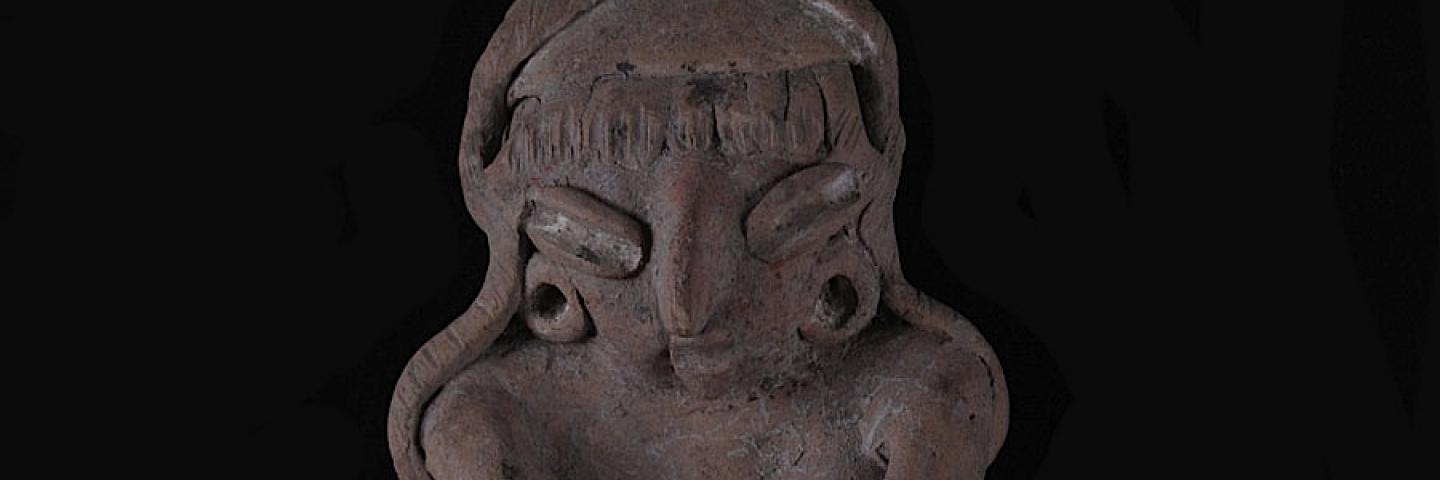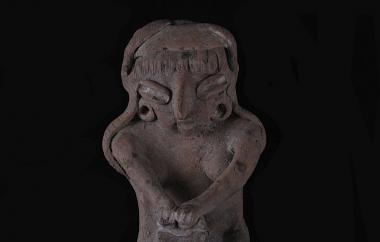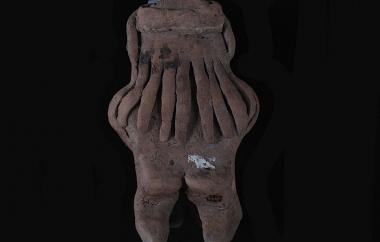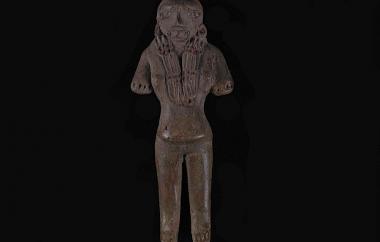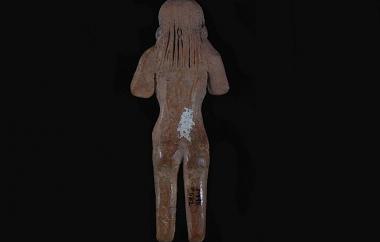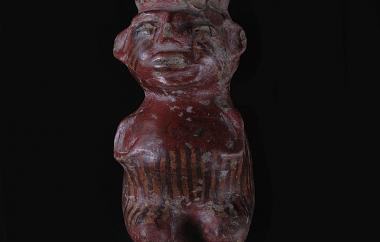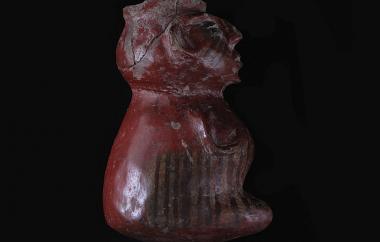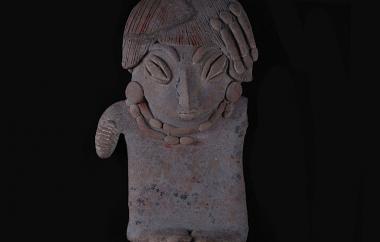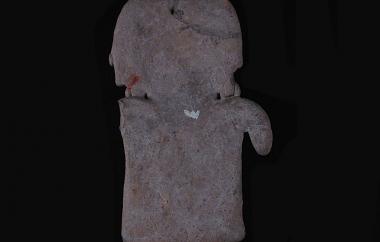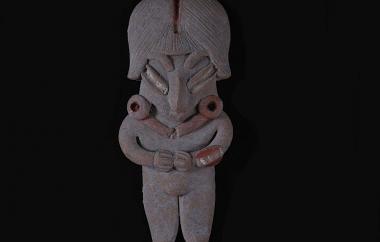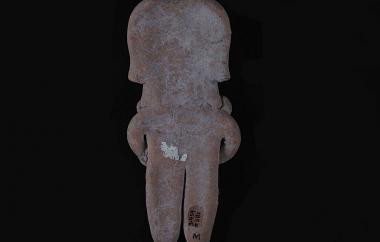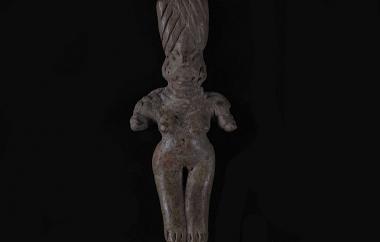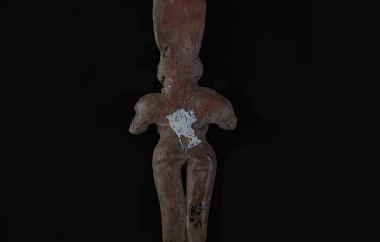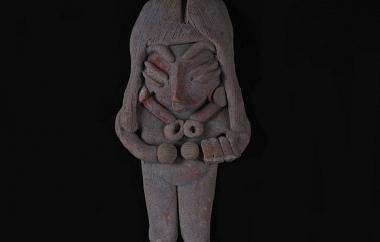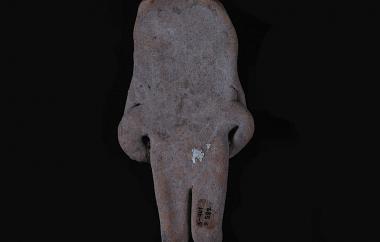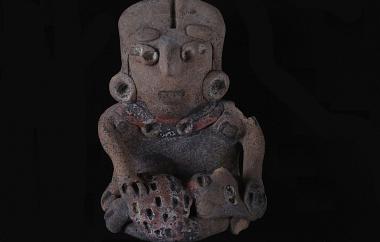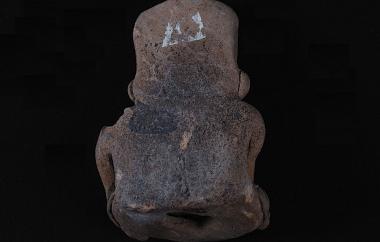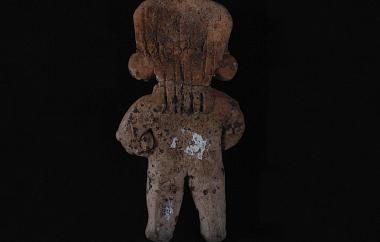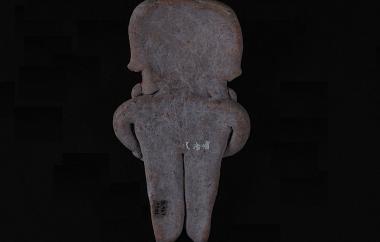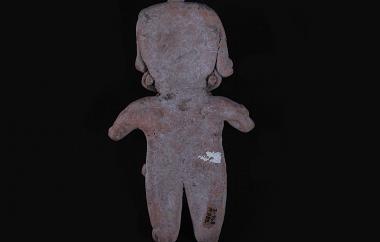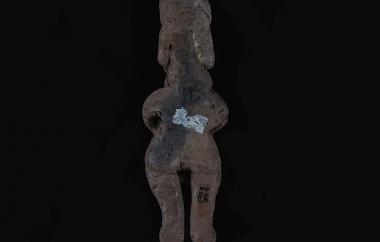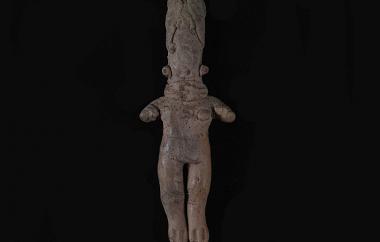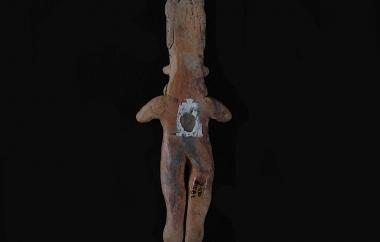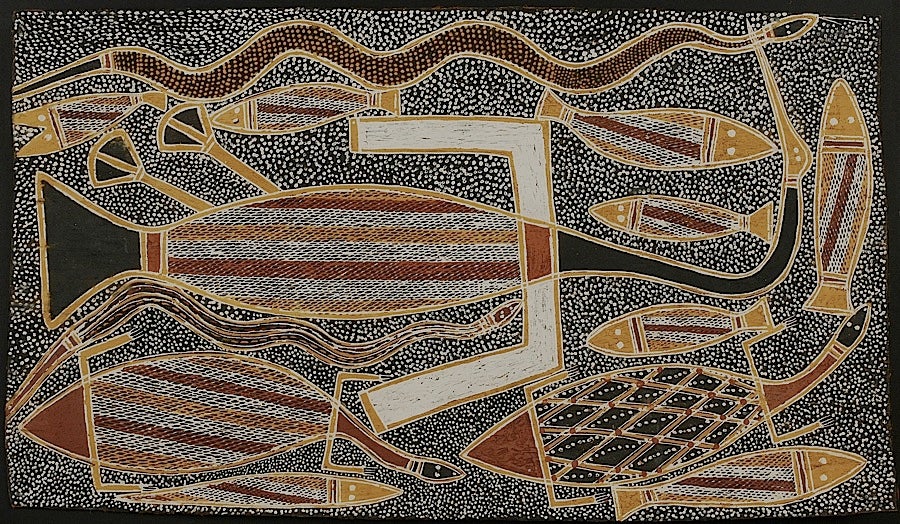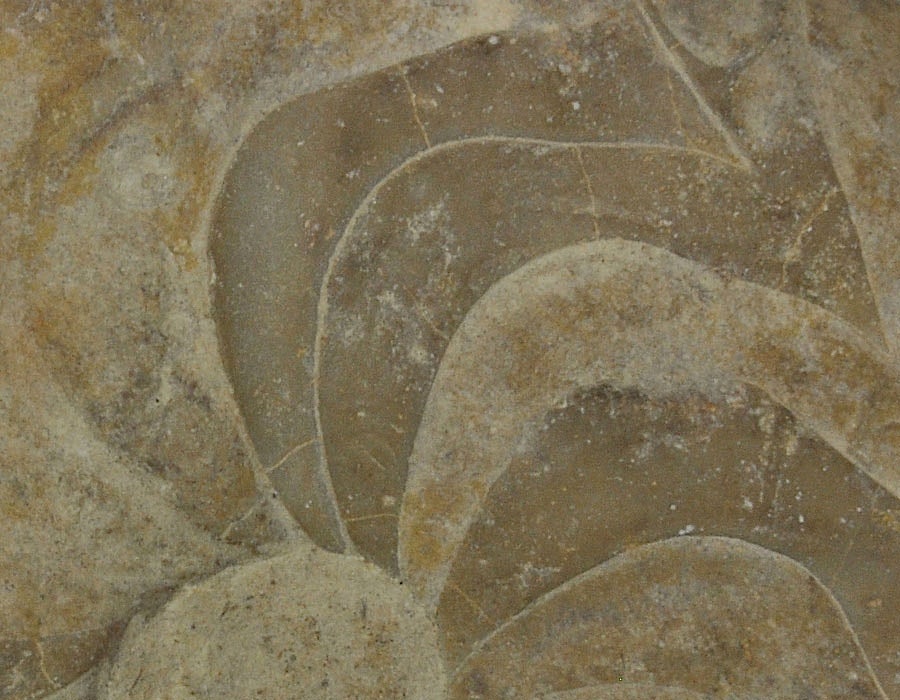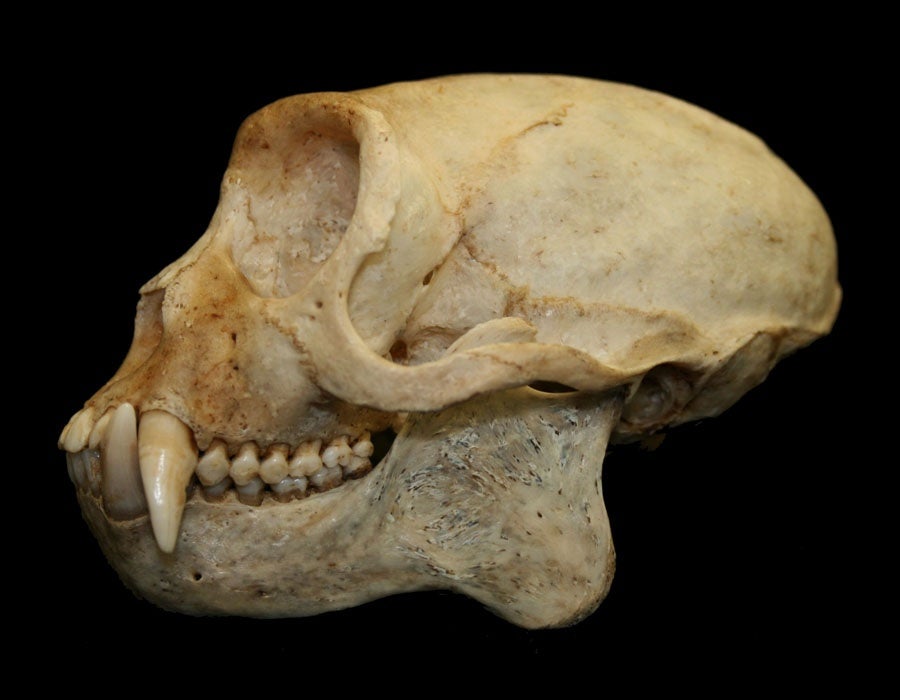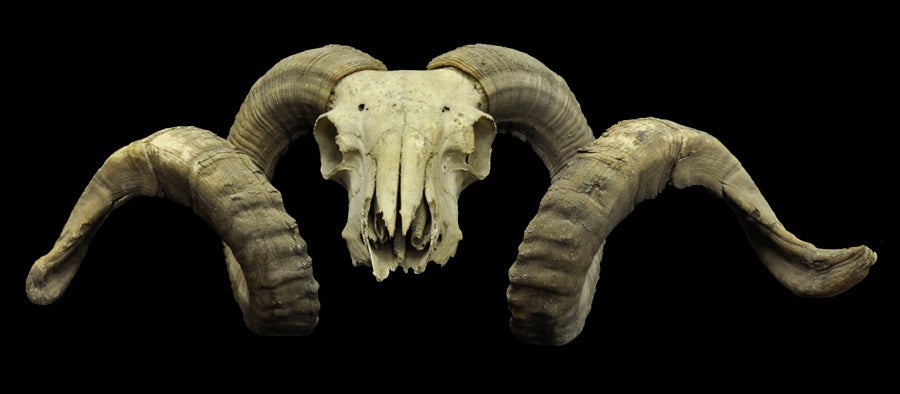The Preclassic period of Mesoamerica is marked by the appearance of well-known Pre-Columbian societies like the Olmec, the Zapotecs, the city of Teotihuacan, and the Maya. It is known for the emergence of agriculture, public architecture, and the development of larger communities.
Chupícuaro refers to a Preclassic site and culture. It was once a source of considerable influence in central Mexico, particularly in ceramic production, encompassing the present Mexican states of Jalisco, Nayarit, Colima, Guerrero, Michoacán, and Guanajuato. Though the main site in Guanajuato is now beneath the waters of an artificial lake created in 1949 by the Solís Dam, excavations conducted by the Instituto Nacional de Antropología e Historia of Mexico have provided a glimpse into the lives and culture of the people who lived there.
The inhabitants of Chupícuaro devoted their time and skills to creating pottery figurines, and other small artifacts. Trading distributed these items into the basin of Mexico and Morelos, and other cultures adopted their style. Characteristically flat, Chupícuaro human figurines can also be realistically three dimensional or shaped into vessels. They are distinguished by their slanted, coffee-bean shaped eyes. The figurines are typically depicted as female, indicated by a part in the center of the hair or headdress, and can be fashioned with intricately molded clay clothing and jewelry. Most figurines were left unpainted, but occasionally some were decorated with bright colors. Hundreds of years later, the remnants of red paint can still be seen on some of their faces and jewelry.
The collection containing these figurines was assembled by a former mayor of St. Louis, Missouri, A. J. Cervantes, to be displayed by the Spanish International Pavilion Foundation of St. Louis at the New York World’s Fair of 1964-65. When the Foundation filed bankruptcy in 1970, the collection passed through several sales before being bought by private individuals from Springfield, Oregon. In 1985 they graciously gifted the items to the Museum of Natural and Cultural History.
Images © UO Museum of Natural and Cultural History.
Further Reading:
Baldinger, Ellen and Baldinger, Wallace S.
1985 Appraisal. Accessions files, University of Oregon Museum of Natural and Cultural History.
Weaver, Muriel Porter
1972 The Aztecs, Maya, and Their Predecessors: Archaeology of Mesoamerica. Seminar Press, New York.
Williams, Eduardo
N.d. Prehispanic West México: A Mesoamerican Culture Area. Foundation for the Advancement of Mesoamerican Studies, INC. Website http://www.famsi.org/research/williams/wm_geography.html, accessed July 2012.
Cat. #3-444
Female Human Figurine Kneeling to Grind Maize in Metate (front). Crafted to be three dimensional, this figurine is fully modeled front and rear. Buff earthenware, unpolished, traces of white paint.
Cat. #3-444
Female Human Figurine Kneeling to Grind Maize in Metate (back). Chupícuaro, Mexico, Late Preclassic period (500 – 0 B.C.E.). Height 3 7/8 in, width 2 7/8 in, depth 2.5 in.
Cat. #3-445
Female Human Figurine (front). Hands and feet have been incised to give the appearance of small fingers and toes. Buff earthenware, stick-polished.
Cat. #3-445
Female Human Figurine (back). Chupícuaro, Mexico, Late Preclassic period (500 – 0 B.C.E.) Height 3.5 in, width 1 in, depth 5/8 in.
Cat. #3-453
Vessel, Kneeling Human (front). Sculpted as an anthropomorphic vessel rather than a flat figurine, a headband ends the head abruptly above the face and doubles as the pot rim. Buff earthenware covered with stick-polished red slip, white and dark brown paint.
Cat. #3-453
Vessel, Kneeling Human (side). Chupícuaro, Mexico, Late Preclassic period (500 – 0 B.C.E.) Height 5 5/8 in, width 3 ¼ in, diameter (rim) 2 1/8 in.
Cat. #3-458
Male Human Figurine (front). Individual characteristics, such as hair, eyes, disc earrings, and double necklace, are filleted--that is, applied as separate pellets to the main body.
Cat. #3-458
Male Human Figurine (back). Chupícuaro, Mexico, Late Preclassic period (500 – 0 B.C.E.) Height 6 in, width 2 ¾ in, depth 5/8 in.
Cat. #2-459
Female Human Figurine (front). The headdress, parted at the middle, is typical Chupícuaro style for female figurines. Buff earthenware, unpolished, traces of red and white paint.
Cat. #3-459
Female Human Figurine (back). Chupícuaro, Mexico, Late Preclassic period (500 – 0 B.C.E.) Height 4 in, width 1 ¾ in, depth 5/8 in.
Cat. #3-460
Female Human Figurine (front). While this figurine is overall rudimentary, great detail and emphasis were given to her truncated headdress. It flares toward the top and has been incised with decorative lines. Buff earthenware, polished, traces of red and white paint.
Cat. #3-460
Female Human Figurine (back). Chupícuaro, Mexico, Late Preclassic period (500 – 0 B.C.E.) Height 3 1/8 in, width 1 ¾ in, depth 5/8 in.
Cat. #3-461
Female Human Figurine with Bone Necklace (front). Locks of filleted hair falling down over the ears reveal the fronts of large earrings. Buff earthenware, unpolished, traces of red and white paint.
Cat. #3-461
Female Human Figurine with Bone Necklace (back). Chupícuaro, Mexico, Late Preclassic period (500 – 0 B.C.E.) Height 3 ¾ in, width 2 in, depth 5/8 in.
Cat. #3-465
Female Human Figurine Seated with Child on Lap (front). This mother is shown breastfeeding. Her small face holds an animated expression. The baby in her lap is wrapped in swaddling clothes which convey a sense of texture. Buff earthenware, unpolished, traces of red and white paint.
Cat. #3-465
Female Human Figurine Seated with Child on Lap (back). Chupícuaro, Mexico, Late Preclassic period (500 – 0 B.C.E.) Height 3 5/8 in, width 2 ¾ in, depth 2 in.
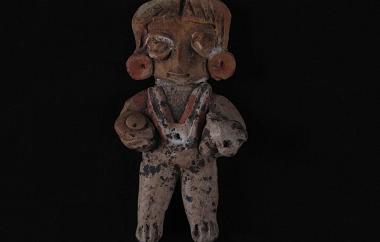
Cat. #3-466 Female Human Figurine with Dog and Metate and Mano (front). This small figurine shows deliberate, realistic details. Eyes have been carefully placed on the dog’s head under her left arm. The handle of the mano on the metate under her right arm can also be distinguished. Buff earthenware, unpolished, traces of red and white paint and encrusted earth.
Cat. #3-466
Female Human Figurine with Dog and Metate and Mano (front). This small figurine shows deliberate, realistic details. Eyes have been carefully placed on the dog’s head under her left arm. The handle of the mano on the metate under her right arm can also be distinguished. Buff earthenware, unpolished, traces of red and white paint and encrusted earth.
Cat. #3-466
Female Human Figurine with Dog and Metate and Mano (back). Chupícuaro, Mexico, Late Preclassic period (500 – 0 B.C.E.) Height 3 1/8 in, width 2 5/8 in, depth ¾ in.
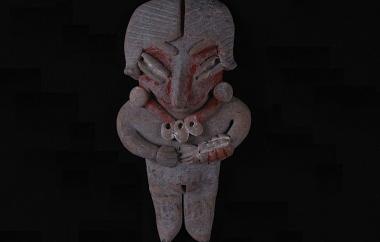
Cat. #3-467 Female Human Figurine with Hands over Abdomen (front). Pointed projections on this figurine’s feet suggest footwear. The red paint of her three-part bracelet and necklace are still bright, and the oval pendants representing shells retain some of their white pigment. Buff earthenware, unpolished, traces of red and white paint.
Cat. #3-467
Female Human Figurine with Hands over Abdomen (front). Pointed projections on this figurine’s feet suggest footwear. The red paint of her three-part bracelet and necklace are still bright, and the oval pendants representing shells retain some of their white pigment. Buff earthenware, unpolished, traces of red and white paint.
Cat. #3-467
Female Human Figurine with Hands over Abdomen (back). Chupícuaro, Mexico, Late Preclassic period (500 – 0 B.C.E.) Height 4.5 in, width 2 3/8 in, depth 5/8 in.
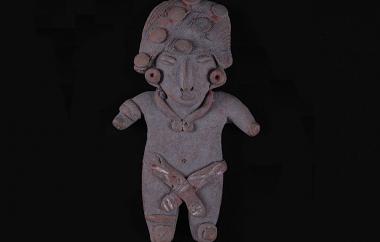
Cat. #3-468 Male Human Figurine (front). Stature and design are characteristic of Chupícuaro male representations, but significant departures from the true style identify this as a modern fake, slipped into the collection during the first wave of enthusiasm for Chupícuaro figurines following the 1946 excavation. The crossed belt over the loins, button-like hair ornament, small toe on each foot, noticeably subdued coffee-bean shaped eyes, and naturalistic perforations for nostrils instead of the usual punctate indications, all denote the figurine was crafted in the 20th Century. Buff earthenware, unpolished, traces of red and white paint.
Cat. #3-468
Male Human Figurine (front). Stature and design are characteristic of Chupícuaro male representations, but significant departures from the true style identify this as a modern fake, slipped into the collection during the first wave of enthusiasm for Chupícuaro figurines following the 1946 excavation. The crossed belt over the loins, button-like hair ornament, small toe on each foot, noticeably subdued coffee-bean shaped eyes, and naturalistic perforations for nostrils instead of the usual punctate indications, all denote the figurine was crafted in the 20th Century. Buff earthenware, unpolished, traces of red and white paint.
Cat. # 3-468
Male Human Figurine (back). Imitation of Late Preclassic period (500 – 0 B.C.E.), 20th Century, C.E. Height 4 5/8 in, width 2 7/8 in, depth 1 in.
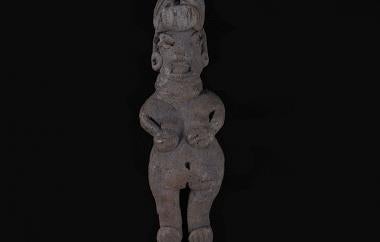
Cat. #3-469 Female Human Figurine with Hands over Breasts (front). A completely flat back indicates that this figurine was made by pressing the clay against a back-board. She was molded to be completely nude and curvaceous, perhaps to emphasize fertility. Buff earthenware, unpolished, traces of white paint.
Cat. #3-469
Female Human Figurine with Hands over Breasts (front). A completely flat back indicates that this figurine was made by pressing the clay against a back-board. She was molded to be completely nude and curvaceous, perhaps to emphasize fertility. Buff earthenware, unpolished, traces of white paint.
Cat. #3-469
Female Human Figurine with Hands over Breasts (back). Chupícuaro, Mexico, Late Preclassic period (500 – 0 B.C.E.) Height 3 5/8 in, width 1 1/8 in, depth 5/8 in.
Cat. #3-470
Female Human Figurine (front). Figurines featured with a tight choker, like this one, are generally crudely modeled. Care has been given to her high headdress, however, which is decorated with a pair of horns in relief. Buff earthenware, polished, unpainted.
Cat. #3-470
Female Human Figurine (back). Chupícuaro, Mexico, Late Preclassic period (500 – 0 B.C.E.) Height 3 1/8 in, width 1 ¼ in, depth 3/8 in.
